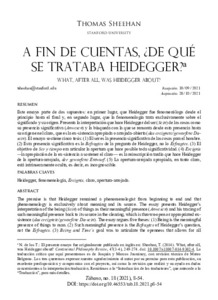Please use this identifier to cite or link to this item:
https://repositorio.uca.edu.ar/handle/123456789/13299| Título: | A fin de cuentas: ¿de qué se trataba Heidegger? What, after all: was Heidegger about? |
Autor: | Sheehan, Thomas | Palabras clave: | Heidegger, Martin, 1889-1976; FENOMENOLOGIA; FILOSOFIA CONTEMPORANEA; METAFISICA; ONTOLOGIA; SER | Fecha de publicación: | 2021 | Editorial: | Universidad Católica Argentina. Facultad de Filosofía y Letras. Centro de Estudiantes de Filosofía | Cita: | Sheehan, T. A fin de cuentas: ¿de qué se trataba Heidegger? [en línea]. Tábano. 2021, 18. doi: https://doi.org/10.46553/tab.18.2021.p8-54. Disponible en: https://repositorio.uca.edu.ar/handle/123456789/13299 | Resumen: | Resumen:
Este ensayo parte de dos supuestos: en primer lugar, que Heidegger fue fenomenólogo desde el
principio hasta el final y, en segundo lugar, que la fenomenología trata exclusivamente sobre el
significado y su origen. Presenta la interpretación que hace Heidegger del ser (Sein) de las cosas como
su presencia significativa (Anwesen) y la búsqueda con la que se remonta desde esta presencia hasta
su origen en el claro, que es la ex-sistencia apropiada o arrojada-abierta (das ereignete/geworfene Dasein). El ensayo sostiene cinco tesis: (1) El ser es la presencia significativa de las cosas para el hombre.
(2) Esta presencia significativa es lo Befragtes de la pregunta de Heidegger, no lo Erfragtes. (3) El
objetivo de Ser y tiempo era articular la apertura que hace posible toda significatividad. (4) Ereignis
—la apropiación de la ex-sistencia a sostener el claro— es la reinscripción tardía que hace Heidegger
de la apertura-arrojada, der geworfene Entwurf. (5) La apertura-arrojada apropiada, en tanto claro,
está intrínsecamente oculta, es decir, es incognoscible. Abstract: The premise is that Heidegger remained a phenomenologist from beginning to end and that phenomenology is exclusively about meaning and its source. The essay presents Heidegger’s interpretation of the being (Sein) of things as their meaningful presence (Anwesen) and his tracing of such meaningful presence back to its source in the clearing, which is thrown-open or appropriated exsistence (das ereignete/geworfene Da-sein). The essay argues five theses: (1) Being is the meaningful presence of things to man. (2) Such meaningful presence is the Befragtes of Heidegger’s question, not the Erfragtes. (3) Being and Time’s goal was to articulate the openness that allows for all meaningfulness. (4) Ereignis—the appropriation of ex-sistence to sustaining the clearing—is the later Heidegger’s reinscription of thrown-openness, der geworfene Entwurf. (5) Appropriated thrownopenness, as the clearing, is intrinsically hidden, i.e., unknowable. |
URI: | https://repositorio.uca.edu.ar/handle/123456789/13299 | ISSN: | 1852-7221 2591-572X (online) |
Disciplina: | FILOSOFIA | DOI: | https://doi.org/10.46553/tab.18.2021.p8-54 | Derechos: | Acceso abierto | Fuente: | Tábano No.18, 2021 |
| Appears in Collections: | TAB - 2021 nro. 18 |
Files in This Item:
| File | Description | Size | Format | |
|---|---|---|---|---|
| a-fin-cuentas.pdf | 1,12 MB | Adobe PDF |  View/Open |
Page view(s)
69
checked on Apr 27, 2024
Download(s)
305
checked on Apr 27, 2024
Google ScholarTM
Check
Altmetric
Altmetric
This item is licensed under a Creative Commons License

